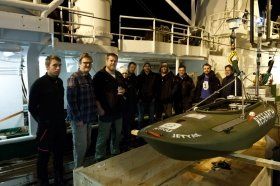Over the last decade, scientists have pieced together the story of what happens with this migration in the Arctic, where it is dark for up to six months of the year. Recent research, including from NTNU, shows that even the weak light of the Moon is enough to trigger a rapid migration to deeper and darker waters. The light from the aurora will also cause this phenomenon.
But this extreme sensitivity to light has a dark side: the light from vessels or other manmade ocean structures is enough to disturb zooplankton movement, and drive the animals into the depths. That can affect scientists’ ability to accurately estimate just how many of the creatures there are.
Read more at Norwegian University of Science and Technology
Image: This Jetyak, originally developed by the Woods Hole Oceanographic Institution, has been modified by Norwegian researchers with equipment that allows them to study the movements of zooplankton in the polar dark, in the waters off of Svalbard. (Credit: Geir Johnsen, NTNU/UNIS)


